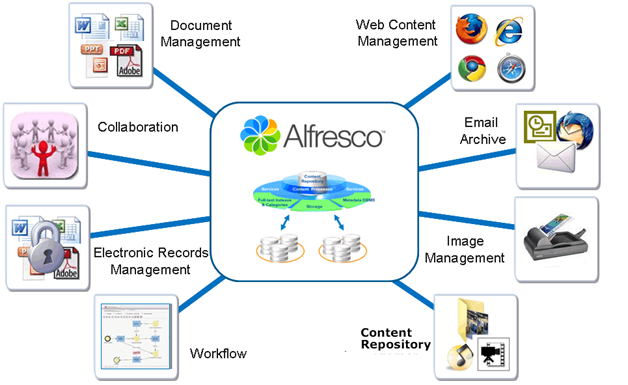





The size of content available through internet is increasing every minute worldwide and so is the need of Content Management Systems. This calls for secure and robust systems to manage huge organizational/business data efficiently with easy interface to access it. There are different Enterprise Content management systems available in market like SharePoint, Magnolia, Drupal, FileNet and few others to meet these requirements. Choosing among these CMS solutions is a difficult task considering all aspects like content size, security, features and most importantly cost. In this blog we will discuss an open source content management system Alfresco which we have successfully implemented in quite a few client engagements. This blog will give basic idea about:
- What is Alfresco?
- Alfresco Products
- Why to use Alfresco?
- A case study
- Alfresco limitations
What is Alfresco?
Alfresco is a free Enterprise Content Management System, developed using JAVA technology for Microsoft Windows and UNIX like operating system. It allows managing different type of content like simple office documents, images, photographs, engineering drawings and even large audio/video files.
Alfresco Products:
Alfresco provides different products to meet different requirement of the industry. For example-
- Alfresco community edition: LGPL licensed suitable to developers and technical enthusiasts.
- Alfresco One-Enterprise edition: Overcomes limitation of community edition by being highly modular and scalable.
- Alfresco cloud Edition: a SaaS version of Alfresco.
- Alfresco mobile: A free mobile document management app for iOS and Android tablets and smartphones.
- Alfresco Activiti: Provides a highly scalable, Java-based workflow and Business Process Management (BPM) platform.
What Alfresco can do?
Let’s have a look at Alfresco features.
- Document management: Can store and track all type of documents.
- Web content management: Allow users with little knowledge of web programming languages or markup languages to create and manage website content with relative ease
- Image management: Can capture, store and reprint images.
- Electronic record management: Can manage records which can be either tangible objects, such as paper documents like birth certificates, driver's licenses, and physical medical x-rays, or digital information, such as electronic office documents, data in application databases, web site content, and electronic mail (email).
- Collaboration: For effective Collaboration Alfresco provides tools to facilitate communication, share information, and run projects within your team as well as to include partners, consultants, external agencies, and customers.
- Workflow: In Alfresco a workflow is a sequence of connected tasks applied to a document or other item of content. Each task can be performed by a person, a group, or automatically. There are a number of tools you get to design, execute, and monitor your workflows.
- Content repository: The content repository is comparable to a database, except that it holds more than data. The binary streams of content are stored in the repository and the associated full-text indexes are maintained by the Lucene indexes.
Why Alfresco?
- Provides a clean and secure web interface for document management.
- Provides all document management features like metadata, versioning, search, audit, workflow.
- Different programmatic ways are available to integrate your application with Alfresco. Some of the interfaces are CMIS, Web scripts, File based access, Open search and feeds, JAVA, PHP and .Net applications.
- Is one of the most portable solutions available having cloud support. You can use it on web, mobile, tablet.
- One of the best features of Alfresco is that it can be easily integrated with Google docs, Office, SAP, AWS and other content tools.
Case study:
In this section we will discuss how Alfresco was used in one of the client engagements. Project background: The application has different types of users like admin / small businesses / agents / individuals who have access to a common portal to buy insurance. In this process of requesting a product, getting approval for it and finally availing it, document processing plays a key part. Requirements: Below section describes different requirements given by client related to document processing.
- End user should be able to upload different types of documents on website in support of the application. The document is further validated by Admin.
- All users of the portal have secure inbox access wherein they are notified about account activities/admin change actions/application statues. These emails should be saved as PDF documents.
- Authorized persons should be able to view/edit the static web content of the application as and when required.
Challenges:We needed one solution to fit all above requirements. We knew the content size would grow with time. The key points which we considered:
- A system with strong security.
- A scalable solution to meet future requirements.
- A system which can be easily integrated with existing Java application.
Solution: After analyzing available ECMs we figured out Alfresco was able to cater to all these requirements and was a cost effective solution. With following features, Alfresco stood as a solution encompassing all our requirements.
- Alfresco guarantees content safety through its security model which is comprised of authentication and authorization.
- Alfresco One-Enterprise edition is highly modular and scalable.
- We could easily integrate Java application with Alfresco using its OpenCMIS extension which depends on Apache Chemistry OpenCMIS libraries.
Now that we have seen how useful alfresco is, let’s see the thing to look out for while using Alfresco.
Alfresco Limitations:
Though alfresco meets most of the requirements there are few limitations of this ECM as per different users.
- The system lacks backup capabilities.
- Its support system needs improvement in Live chat and FAQ sections.
- Few of the UI features can be automated and provide better user experience.
- Enrichment of current content is not so easy, have to reload the content.
- No support for XQuery.
- Content transformation is absent.
Conclusion:
Overall Alfresco meets business and organizational level requirements of content management plus have additional features and a complete mobile solution.
For more information on Enterprise Content Management click here.
References:
Explore Related Offerings
Related Content




Get Started


 View Previous Blog
View Previous Blog



